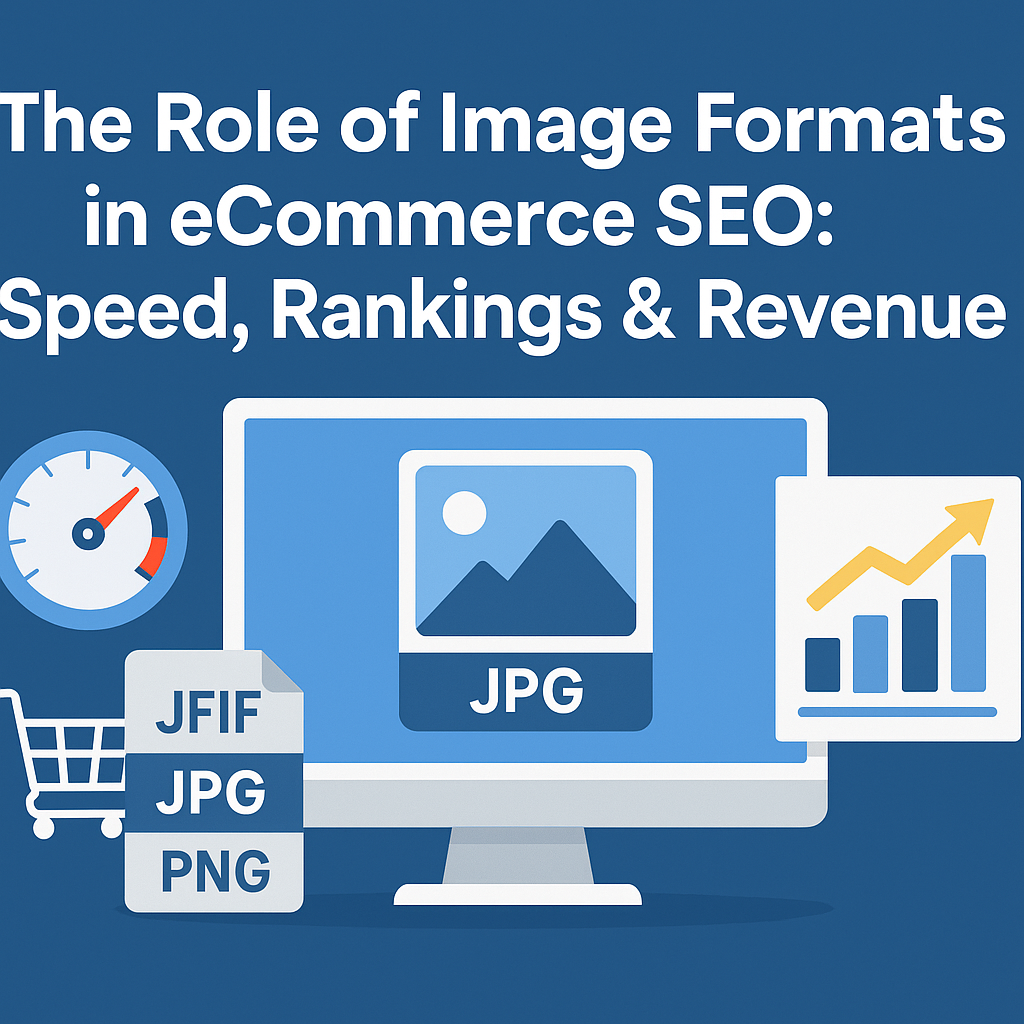
In today’s competitive eCommerce world, your product images do more than just help sell; they also improve your ranking. Making images better has become an important part of technical SEO strategy, especially since Google and other search engines focus on speed, user experience and mobile friendliness in their ranking systems.
In this guide, we will explore how various image formats impact website performance and search engine visibility. We will also give you useful tips on how to choose, compress and use images that improve both user experience and SEO which can lead to more conversions.
1. Introduction to Image SEO in eCommerce
No matter if you have a small online shop or a huge retail website, images play a vital role in both looks and usability. But if your images aren’t optimized they can:
- Make your site slower
- Damage mobile performance
- Raise bounce rates
- Drop your search rankings
Google’s PageSpeed Insights reveals that websites that load quickly usually rank higher and receive more engagement.
Because images make up over 50% of a regular webpage’s total size, improving them is a wise choice for any eCommerce company.
2. Understanding Image Formats
Choosing the right image format isn’t just about the file type, it’s also about finding the best choice for what you need. You can convert JFIF to JPG online without downloading any software. Here’s a quick look at some common image formats and when to use them:
- JPEG: JPEGs are good for product images that showcase detail and color. It keeps file sizes small thanks to lossy compression.
- PNG: Ideal for images that require transparency or crisp edges (like logos). It has larger file sizes but maintains lossless quality. Converting HEIC to PNG is easy, you can convert it online without installing any software.
- WebP: Made by Google, this format gives better compression than JPEG or PNG, while still keeping good quality and a small file size.
- AVIF: The newest choice, offering files that are up to 50% smaller than WebP without losing visual quality.
Quick Format Comparison:
| Format | Compression | Transparency | Browser Support | Best For |
|---|---|---|---|---|
| JPEG | Lossy | No | Excellent | Photos, product images |
| PNG | Lossless | Yes | Excellent | Logos, UI elements |
| WebP | Lossy/Lossless | Yes | ~95% of browsers | Modern web, eCommerce |
| AVIF | Lossy/Lossless | Yes | Growing rapidly | Ultra-optimized stores |
3. Performance Impact of Different Image Formats
Page Speed = Higher Rankings
Google has stated it plainly: the speed at which a page loads affects its ranking. Just a one-second delay in loading can lead to a drop in conversions by as much as 7%. Plus, nothing slows down a site more than large images.
AVIF vs JPEG Case Study:
- An eCommerce homepage that used JPEG images took 3.2 seconds to load.
- By switching to AVIF, that time was reduced to 1.9 seconds.
- The outcome: the bounce rate fell by 18%, and Google Search Console indicated ranking improvements in just 2 weeks.
Mobile Optimization is Essential
Since more than 60% of eCommerce traffic is now coming from mobile devices, it’s super important to use responsive image formats that scale well and load quickly. WebP and AVIF are way better than older formats in this regard.
4. Best Practices for Image Optimization
Want images that are both beautiful and optimized? Follow these proven techniques:
Choose the Right Format
- Use WebP or AVIF where supported
- Fallback to JPEG/PNG for older browsers (via <picture> tag)
Compress Without Losing Quality
- Use tools like TinyPNG, Squoosh or command-line tools like ImageMagick or cwebp
- Aim for compression ratios of 60-80%
Resize for Purpose
- Don’t use 2000px-wide images for 300px display areas
- Create multiple sizes for responsive loading (thumbnails, medium or full)
Optimize Alt Text
- Describe the image purposefully (“Blue cotton shirt on model front view”)
- Helps with image SEO and accessibility
Use Semantic Naming
- red-running-shoes-men.jpg instead of IMG0038.jpg
- Keywords in file names improve search relevance
5. Technical Implementation Strategies
Use the <picture> Element for Modern Fallbacks
<picture>
<source srcset="product.avif" type="image/avif">
<source srcset="product.webp" type="image/webp">
<img src="product.jpg" alt="Men’s blue denim jacket">
</picture>This ensures that new formats are used when they can be, and if they can’t older browsers will fall back to JPEG or PNG.
Add Structured Data
Enhance your rich snippets with Schema.org ImageObject. Example:
{
"@context": "https://schema.org",
"@type": "Product",
"name": "Running Shoes",
"image": "https://example.com/images/running-shoes.webp"
}Create an Image Sitemap
Improve discoverability by submitting an image sitemap to Google Search Console.
6. Measuring Image SEO Success
Keep an eye on how well your image optimization is working with these tools:
- Google PageSpeed Insights – See how fast your pages load and how well your images are performing.
- Google Search Console – Track how your images are indexed along with impressions and clicks.
- Lighthouse Audit – Receive technical advice and scores on your images.
- Heatmaps and Analytics – Analyze user interactions with your optimized images (like product zoom and clicks).
7. Conclusion: Actionable Takeaways
Image formats might seem like a small thing, but they can really affect your site’s performance and rankings. In eCommerce, every second and pixel matters.
Key Actions You Can Take Today:
- Start using WebP or AVIF for your product and banner images
- Compress your current images to speed up load times
- Use responsive image techniques with <picture> and various sizes
- Write clear alt text and use meaningful filenames
- Monitor results with Google tools and make adjustments regularly
By carefully selecting and optimizing image formats, you’re not just making your visuals better, you’re boosting your SEO, enhancing user experience and increasing your store’s chances of conversion.